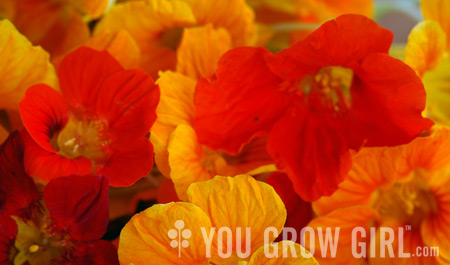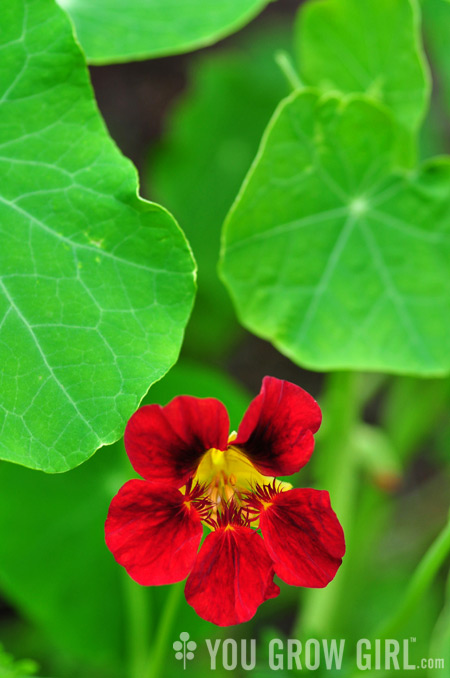
Happy Summer Solstice!!!
My third article in this season’s Globe & Mail Kitchen Gardening column was published on Saturday. The topic is growing nasturtiums to eat.
One of my goals with the series is to publish articles while there is still time for as many gardeners across Canada as possible to get that particular plant into the soil (I am writing to a Canadian audience with these articles…. not easy since Canada is massive and growing conditions vary radically). As a result, my nasturtium article was published before my own plants had flowered. They still haven’t! There are lots more nasturtium varieties than can be found in the local gardening shop — I try to grow a different variety every year. This summer I am growing ‘Creamsicle.’ I can’t wait for the soft orange flowers to come up.
Meanwhile, my friend Barry was daring and put his seeds into the soil well before the last frost date for our region. As luck would have it the weather was unseasonably warm and his flowers are already up. I managed to shoot the very first open bloom on the day my article and photos were due. How’s that for timing?
Here it is:

The variety is called ‘Mahogany’.
Do you have a favorite nasturtium variety? Which variety are you trying for the first time this year?
—————————————-
Bold and brassy nasturtiums (Topaeolum majus) are true crossover plants. Best known as summer flowering annuals used to brighten up hanging baskets and beds, they are also edible. In fact, the entire plant is. But unlike many fringe foods, nasturtiums do not taste suspiciously like grass.
The youngest, juiciest leaves, which taste very much like watercress, lend a peppery zing to salads or cream cheese dip. The flowers are surprisingly spicy too, but with a shot of sweet nectar that sits in the spur. I “pickle” the green seedpods in rice vinegar and make vibrant salad dressings by steeping the colourful flowers in vinegar. Nasturtiums are good summer eating and the only way you can get them is by growing your own.
An old gardener’s maxim — “Be nasty to nasturtiums; they like it” — is a good (if sadistic) reminder not to coddle this easy-to-grow plant. You’ll grow the best and most abundant flowers in sunny gardens where the soil is very well draining, slightly dry and nutrient-poor. Too much nitrogen and you risk suffocating the garden (and the house, too) under Jurassic Park plants with massive, lush leaves, but you won’t get any flowers.
I find it easier to get the balance of drainage and nutrition right by growing in pots. My all-time favorite is ‘Empress of India’, a dwarf variety with smaller, blue-green pads and deep red flowers. It will happily grow in a small six-inch-deep pot or shallow window box. Varieties that grow in 10-to-12-inch mounds, such as ‘Creamsicle’ and ‘Cherries Jubilee’, are also good choices for pots that are eight inches or deeper. Even deeper 12-inch pots can handle mammoth types listed as climbers or creepers. ‘Moonlight’ is showy yet graceful and can be trained up a wall trellis or used to cover a fence.
But don’t practice cruel-to-be-kind tough love on container-grown plants. Never let them dry out, for instance. And give them a slightly shadier spot than you would in-ground plants. Alternatively, tuck them underneath the protective canopy of taller plants like tomatoes or cucumbers and let the wiry, lily-pad-shaped foliage drape over the edge of the pot.
Whether growing from seed or transplants, the best time to start nasturtiums is after all danger of frost has passed. Growing from seed is simple enough and the best way to enjoy unusual varieties that aren’t available as transplants. Press the peas-sized seeds directly into the soil where you intend to grow them about one inch deep and four inches apart. You can pre-soak the seeds if you prefer, but I find unsoaked seeds germinate just the same. Treat them well (or poorly, as the case may be) and you’ll find yourself flush with flowers about six to eight weeks after planting seeds. Poor care or a rambunctious disposition may be the origin of their nickname — “nasties” — or perhaps it’s their penchant for attracting hoards of jittery little aphids around new leaves and flowers. Some gardeners grow nasturtiums as a sacrificial trap plant in order to protect more prized crops, pulling the entire plant out once they become infested. Since nasturtiums are a prize in themselves, I prefer to just spray the little suckers off with water as best I can and cut the plants back if the population grows out of hand. Some plants are inevitably lost by mid-summer, but I just push a few more seeds into the open space for another go before the frost drops them all dead.
These gorgeous pictures are making me long for some of these delicious beauties. Gonna add “start nasturtium seeds” to the long, long to-do list, dammit!
My favourite is still ‘Salmon Baby’ which despite it’s sucky name is really beautiful,
Ciao Gayla-
As fate would have it, I’ve chosen Salmon Baby and Mahogany for the 2 back beds in between the different basils this year. I had extra Dwarf Cherry Rose seedlings so I shoehorned them in front of the kale in the brassica bed as well as the half barrel for our tenants. My Empress of Indias didn’t germinate, but that’s ok as I’ve chosen many different ones to grow this year. Tom Thumbs, another dwarf variety, are growing amongst my Blue Jade corn in a half barrel and Amazon Jewels, a splatter-leafed Alaska type will be trained up the Munchkinland trellis this year. All of these are new to me except for the Dwarf Cherry Rose, which I really like for smaller spaces.
I love the flavour of the flowers and the leaves. We often substitute them for lettuce in BLT sandwiches and also salads when the arugula has long bolted. The flowers are also good for stuffing with herbed cream cheese.
As long as we don’t have a severe drought, it should be a good year for nasturtiums. They sure did great the last two years with all the rain.
my mom grows nasturtiums every year but we have never eaten them.
I really should start eating the nasturtiums that are running wild here, attempting to colonize my garden (or is it the other way around). Might help keep things in check… heh.
We are still waiting for ours to bloom! Thing to look forward to!
I’m growing Empress of India this year, and I couldn’t be happier with them. Nasturtiums are the most gratifying thing I’ve ever grown- they grow so fast and large, and flower quickly!
excellent article and photos! i’m growing nasties for the first time this year: peach melba that i started in containers months ago (blooming like crazy now), and alaska mix that are just starting to come up.
i’ve been eating some very decorative salads…here’s a pic: http://yourapplesaremyoranges.blogspot.com/2010/06/i-dont-know-about-you-but-this-is-what.html
So happy to read this informative article. These flowers were on my list this year as I embark on my first vegetable garden. I tucked seeds all over the place, at the base of an apple tree, by the kitchen door, in one end of a bed where I am growing a watermelon, and they are all growing at different rates. I used tom thumb dwarf for the garden and a generic climbing variety for outside the garden. I had no idea that there were so many varieties. I’m already thinking about next year.
I love nasturtiums. Their peppery flavor enhances salads so beautifully. Mix with some arugula micro greens and it’s truly heaven on earth. I don’t have any growing right now as when I did grow them, aphids took over. The first year, I grew them, black aphids covered them. As a new gardener, I thought aphids were only green. What is the best ‘organic earth friendly pesticide’ is good to use. Or, just a garden soap??? I’m an indoor micro green gardener, so I don’t have to worry about those types of bugs anymore, but looking at your beautiful pics, I would like to give it a try again.
Aphids and nasturtiums just seem to grow together. I get them up on the 14th floor. Of all the creepy things that attack plants, aphids do not make me squeamish so my way of getting rid of them is this. Have a large bowl or bucket of water, run your fingers through the stems and foliage and grab the aphids. dip your hand in the water to wash them off and repeat. I find nasturtium leaves sensitive to any sprays, no matter how earth friendly. Another member of the Topaeolum family is Canary Creeper. easy to grow and fun yellow flowers.
i started my seedlings in January and planted them outside in April. i’ve got TONS of blooms… they’re especially good in salad rolls with some volunteer cilantro :)
Ok I was wondering what took them so long to bloom last year. I was giving them lots of worm tea from my worm farm along with the other neighboring plants who really did want it. I did get the HUGE leaves you spoke up but no flowers until the end when I wasn’t doing anything with that part of the plot. Thanks Gayla! I always enjoy your site!